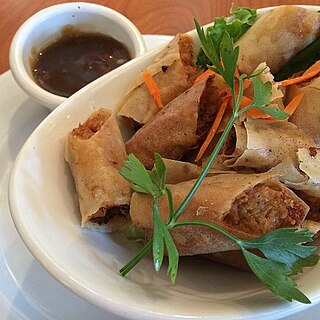Top Qs
Timeline
Chat
Perspective
Lumpiang Shanghai
Filipino deep-fried crêpe-wrapped pork From Wikipedia, the free encyclopedia
Remove ads
Lumpiang Shanghai (also known as Filipino spring rolls, or simply lumpia or lumpiya) is a Filipino deep-fried appetizer consisting of a mixture of giniling (ground pork) with vegetables like carrots, chopped scallions or red onions and garlic,[1] wrapped in a thin egg crêpe. Lumpiang Shanghai is regarded as the most basic type of lumpia in Filipino cuisine, and it is usually smaller and thinner than other lumpia variants.[2][3]
Remove ads
Names and origin
Lumpia wrapper was introduced to the Philippines by early Hokkien immigrants from Fujian. The name of the wrapper is derived from Hokkien: "lun" means wet, moist, or soft, and "pia" means cake or pastry. They have been thoroughly nativized to Philippine cuisine and are found throughout the islands. They use various fillings inspired by local ingredients and dishes, and the later cuisines of Spain, China, and the United States.[4][5][6] It is a Filipino version of Taquito; the name of the wrap is derived from two Hokkien words, lun meaning moist and pia meaning pastry.[1] The early version of the wrap is made of Tortilla from Spanish corn flour Masa until Chinese migrants opened a business in the Philippines and introduce their own version of wrap made from rice flour hence, it's called Lumpia wrapper [2][7] Lumpia itself is a combined Spanish and Chinese Filipino influenced origin, brought over by migrants from Fujian and early Spanish colonial era. But Filipino lumpia varieties, as well as the wrappers used (which are thinner in comparison to Chinese spring roll wrappers) have been nativized.[3][8][9]
Remove ads
Description
Summarize
Perspective

Lumpiang Shanghai is regarded as the most basic type of lumpia in Filipino cuisine. Lumpiang Shanghai can be defined by its use of giniling (ground pork) as the main stuffing. The ground pork is sautéed with finely chopped carrots, garlic, onions, shallots, and salt and pepper to taste. A small amount of it is then placed on a lumpia wrapper (a thin egg crêpe) which is then rolled around it into a thin cylinder. The ends are secured by wetting it with a bit of water or egg whites. Sometimes, the fried giniling are further moistened with raw eggs so they retain their shape better. It is then deep-fried until golden brown.[3][10][9][11][12][13]
It is commonly served with agre dulce (sweet and sour) dipping sauce (which accentuates its "Chinese-ness").[2][10][14] It can also use other common lumpia dipping sauces like banana ketchup, sweet chili sauce, garlic mayonnaise, or vinegar with labuyo peppers and calamansi.[3]
Lumpiang Shanghai is one of the most ubiquitous dishes served in Filipino parties, along with variations of pancit (noodles). They are commonly prepared ahead and stored in the refrigerator, and only deep-fried immediately before serving.[3][15][16]
Remove ads
Variations
The basic recipe can be modified easily and is adapted to numerous variants.[7] However, unless the variants still use ground pork as its main stuffing, the variants are usually simply referred to generically as "lumpia".[16][17][18]
Common variations include using ground beef, ground shrimp, or shredded chicken. Other ingredients may also be added, including green peas, raisins, cheese, peppers, milk, water chestnuts, singkamas (jicama), and kintsay (Chinese celery), among others.[2][15][16][14]
See also
Wikimedia Commons has media related to Lumpiang Shanghai.
References
Further reading
Wikiwand - on
Seamless Wikipedia browsing. On steroids.
Remove ads

